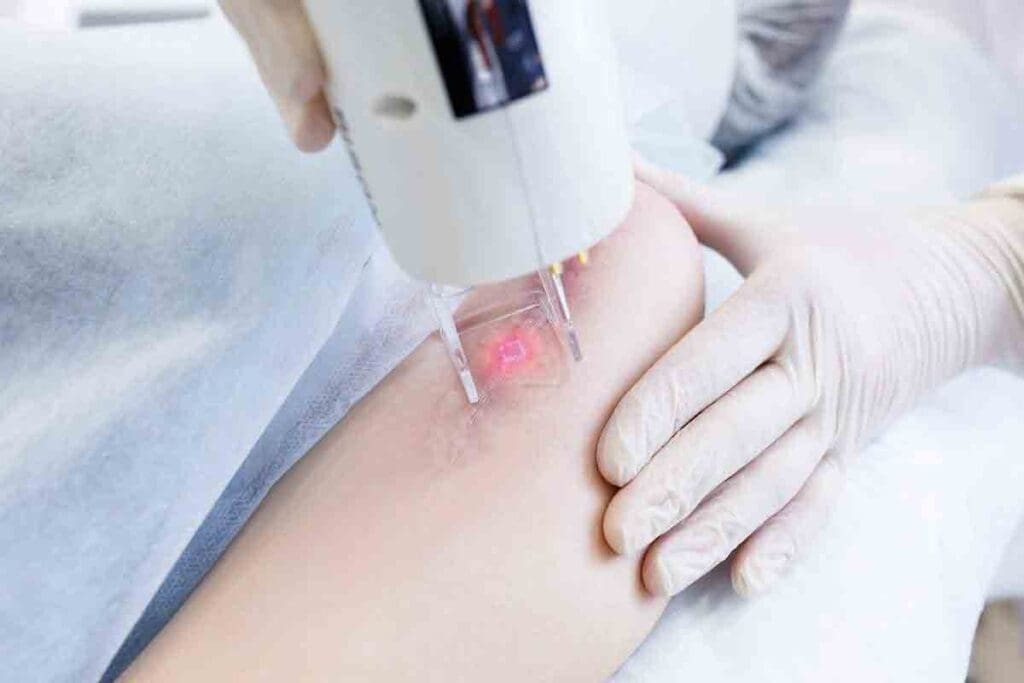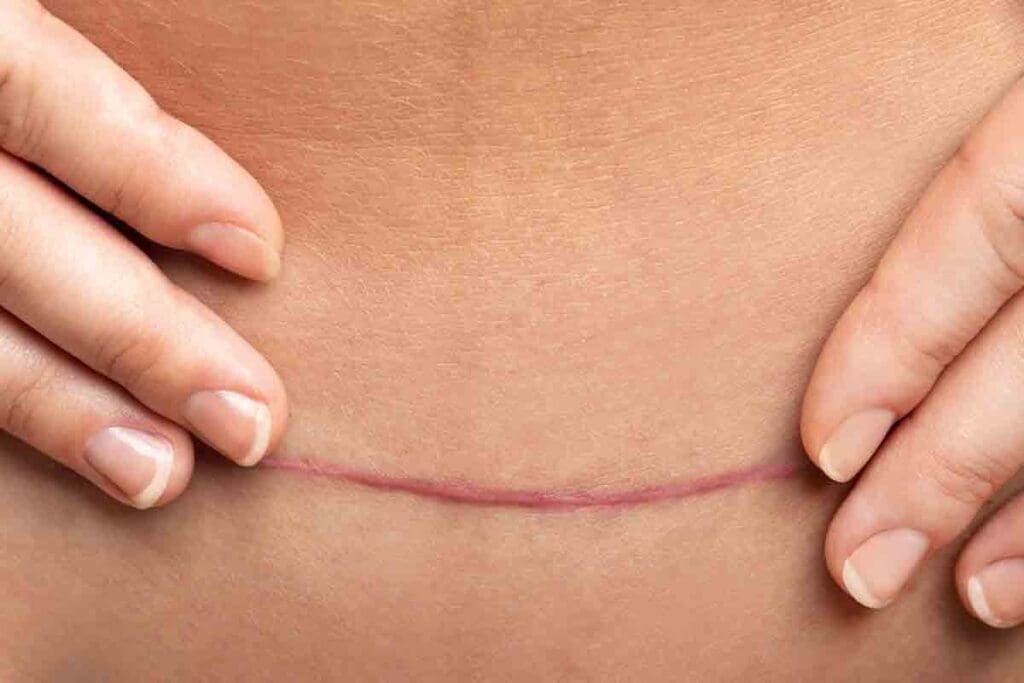Last Updated on November 26, 2025 by Bilal Hasdemir

Abdominal adhesions are bands of tissue that form between organs in the belly. They often happen after surgery. These adhesions can lead to chronic pain and blockages in the intestines, making life hard.
If you’ve had surgery in your belly, you might know the pain or digestive issues that can follow. At Liv Hospital, our teams use the latest methods to prevent and treat these adhesions. We aim to fix the problem at its source.
It’s important to manage abdominal adhesions to ease pain and digestive issues. Knowing what causes and symptoms of adhesions are is the first step to managing them well.

Abdominal adhesions are bands of fibrous tissue that connect organs in the abdominal cavity. They can form after surgery, inflammation, or when the body heals itself.
Abdominal adhesions are fibrotic bands between organs or the abdominal wall. They can cause organs to move out of place or stick together. This can lead to bowel obstruction, chronic pain, and other issues.
The formation of adhesions involves complex cellular and molecular processes. It is influenced by tissue injury, ischemia, and foreign materials.
Scar tissue in the abdomen forms as the body heals after injury or surgery. When tissues are damaged, the body repairs them by depositing collagen and other proteins. This can lead to adhesions over time.
The healing process includes inflammation, cell growth, and remodeling. The extent of tissue damage, infection, and genetic factors can affect adhesion formation.
Several factors increase the risk of abdominal adhesions. Previous abdominal surgery, inflammatory conditions like endometriosis, and trauma are among them. These factors can lead to adhesions.
Knowing these risk factors helps identify who is more likely to develop adhesions. It also allows for preventive measures to reduce the risk.

It’s important to know why abdominal adhesions happen. They can form when the abdominal cavity gets irritated or inflamed. This irritation leads to scar tissue that can bind organs or intestines together.
Most adhesions come from past abdominal surgery. Surgery is needed, but it can cause adhesions as the body heals. Studies show that up to 90% of patients after major surgery get adhesions.
Handling tissues during surgery and infections can cause adhesions. Surgeons try to reduce this with new techniques and materials.
Laparoscopic surgery, with smaller cuts, helps lower adhesion risk. But, adhesions can happen even with these new methods.
Inflammatory conditions in the belly are another big reason for adhesions. Endometriosis, for example, can cause inflammation and adhesions. Crohn’s disease and diverticulitis also lead to adhesions because of chronic inflammation.
Chronic inflammation is key in these conditions. Treating the underlying disease is vital to prevent or reduce adhesions.
Abdominal trauma can also cause adhesions. This trauma can come from accidents or injuries. The body’s healing process can sometimes lead to adhesions.
In some cases, adhesions from trauma may not show up until years later. They can cause symptoms like bowel obstruction or chronic pain. Knowing about past abdominal trauma is important for diagnosing and treating adhesions.
It’s important to know the signs of abdominal adhesions to get the right treatment. These adhesions can cause mild pain or serious problems.
Adhesions can make your belly feel tight, hurt a lot, or even feel sharp. The pain might always be there or come and go. It can get worse when you move or change positions.
When intestines stick together, you might feel bloated, nauseous, or want to vomit. Sometimes, this can block your bowel, causing a lot of pain, trouble passing gas, and constipation.
Adhesional bowel obstruction is a serious issue that needs quick medical help. Look out for severe abdominal pain, persistent vomiting, abdominal tenderness, and fever. If you see these signs, go to the emergency room right away.
Knowing these symptoms can help you spot problems with abdominal adhesions early. This way, you can get the care you need.
Finding abdominal adhesions is tricky. It takes a mix of different tests. The problem is, adhesions can show up in many ways. And our current tools have their limits.
First, doctors do a detailed check-up and physical exam. They look at the patient’s past for surgeries, inflammation, or injuries that might lead to adhesions. They check for tenderness, guarding, or masses that could mean adhesions are there.
But, these signs can also mean other problems. So, it’s not always clear if adhesions are the issue.
Knowing the patient’s history is key. It helps doctors spot risks for adhesions, like past surgeries or inflammatory diseases. The physical exam might hint at adhesions, but it’s not always clear.
Imaging tests are important in figuring out what’s going on. They help rule out other problems and sometimes show adhesions. The usual tests are:
But these tests have their limits. They might not see thin adhesions or those that don’t distort the bowel much. So, a test that doesn’t find adhesions doesn’t mean they’re not there.
Laparoscopy is the top choice for finding abdominal adhesions. It’s a small surgery where a camera is used to see inside the belly. It can spot adhesions, see how bad they are, and sometimes fix them at the same time.
Laparoscopy is very good at finding adhesions and can even treat them. But,it’s a big deal because it’s surgery. It carries risks like bowel injury or infection. It’s usually for when other tests don’t work and doctors are really unsure.
For those with mild abdominal adhesion symptoms, non-surgical methods can help a lot. These methods include making lifestyle changes and managing symptoms. They are key to dealing with adhesions without surgery.
Diet is very important in managing adhesion symptoms. Increasing fiber intake helps with bowel movements and prevents blockages. Foods like fruits, veggies, and whole grains are good sources of fiber. Also, staying hydrated helps avoid constipation and keeps the bowels healthy.
It’s wise to avoid foods that cause gas and bloating. These can make adhesion symptoms worse. Some people might find a low-FODMAP diet helpful, as it limits hard-to-digest carbs.
Physical therapy can help manage adhesion symptoms. Gentle exercises and stretches can improve mobility and lessen pain. Pelvic floor physical therapy is great for pelvic pain from adhesions.
Yoga and Pilates are also good, as they build flexibility and strength. But it’s important to have a qualified instructor who can adjust exercises for your needs.
Good bowel management is key for those with adhesions. Keeping a regular bowel routine and avoiding straining is important. Stool softeners or laxatives might be suggested to prevent constipation and blockages.
In some cases, probiotics are recommended to support a healthy gut. This can help with digestion and overall gut health.
Managing adhesion-related pain is key to improving life quality. Abdominal adhesions, like scar tissue in the colon and scar tissue in the intestines, cause a lot of pain. It’s vital to manage this pain well for patient care.
For mild to moderate pain, OTC meds can help. Acetaminophen and NSAIDs like ibuprofen are common choices. They help with pain and reduce inflammation from adhesions, including omental adhesions.
Always follow the dosage instructions and talk to a doctor before taking meds for a long time. This ensures the treatment won’t harm other health conditions or meds.
If OTC meds don’t work, prescription meds might be needed. These can include stronger pain relievers or meds for nerve pain from adhesions. The right prescription depends on the pain level, health, and past treatments.
Pregabalin has been shown to help with adhesion pain, mainly neuropathic pain. It works by changing how nerves send signals to the brain.
Studies and clinical evidence back using pregabalin and other nerve pain medications for complex adhesion pain. But always get a doctor’s advice before starting these meds.
In summary, meds are a big part of managing adhesion pain. From OTC to prescription meds like pregabalin, there are many options. The best plan is one that fits the patient’s needs and is watched by a healthcare provider.
When other treatments don’t work, surgery is often needed to remove adhesions. These adhesions can cause serious problems like intestinal blockage. They can also greatly lower a person’s quality of life.
Surgery is considered when symptoms are severe or complications occur. Doctors usually decide on surgery after other treatments have not helped enough.
Common reasons for adhesion removal surgery include:
Experts say, “Surgery is often the last choice but can greatly help those with severe adhesions.”
“The goal of adhesion removal surgery is to restore normal anatomy and alleviate symptoms, improving the patient’s quality of life.”
Before surgery, it’s important to weigh the risks and benefits. Surgery can offer relief, but it also has risks like infection and adhesion recurrence.
| Risks | Benefits |
| Infection | Relief from chronic pain |
| Bowel injury | Resolution of bowel obstruction |
| Adhesion recurrence | Improved quality of life |
Getting ready for surgery involves a detailed medical check-up. This includes imaging and a review of your medical history. You’ll also get instructions on what to do before surgery, like diet and medication.
It’s key to know what to expect from surgery for a good recovery. Talking to your doctor about your concerns and hopes can help make the process smoother.
There are different ways to remove abdominal adhesions through surgery. Each method has its own benefits, and when to use it. The choice depends on how bad the adhesions are, the patient’s health, and the surgeon’s skill.
Laparoscopic adhesiolysis is a minimally invasive surgery. It uses small cuts and a laparoscope to see and remove adhesions. This way, the surgeon can work on the adhesions without touching much of the body.
Advantages of laparoscopic adhesiolysis include:
For very complex cases, open surgery is needed. This method uses a bigger cut to directly access the belly. It’s used when adhesions are severe or near important parts.
Open surgical approaches are typically used in cases of:
| Surgical Approach | Indications | Benefits |
| Laparoscopic Adhesiolysis | Mild to moderate adhesions, minimal previous surgeries | Less invasive, quicker recovery, less scarring |
| Open Surgery | Complex, extensive adhesions, previous failed laparoscopic attempts | Direct access, suitable for complex cases |
Robotic-assisted surgery is a new way to remove adhesions. It uses technology to make laparoscopic surgery even better. It offers clearer views and more precise movements.
Benefits of robotic-assisted adhesion removal include:
Choosing the right surgery for adhesions is key to good results. Each method has its own time and place. The decision depends on the patient and the surgeon’s skills.
Knowing what to expect after adhesiolysis surgery is key. The recovery includes caring for the wound, managing pain, and slowly getting back to daily life.
The first few days after surgery are critical. Patients stay in the hospital to manage pain and watch for any issues. Post-operative care instructions help ensure a smooth recovery at home.
Managing pain is a big part of getting better. You might feel pain from the incision, healing inside, or leftover adhesions. Here are some ways to handle it:
Talk to your healthcare provider about your pain. They might need to change your pain plan.
How long it takes to get back to normal varies. It depends on the surgery, how you heal, and if there are any problems. Here’s a general idea of what to expect:
| Timeframe | Activity Level |
| 1-2 weeks | Limited activity, start with light walking and stretching. |
| 4-6 weeks | More mobility, start doing most daily tasks again. |
| 8-12 weeks | Almost fully recovered, can do hard activities and exercise. |
By following the recovery plan, you can heal well and avoid future problems. This includes taking care of your wound, managing pain, and slowly getting back to your usual activities.
To avoid the problems caused by abdominal adhesions, taking certain steps is helpful. These adhesions can cause a lot of pain and even block the intestines. It’s important to know how to prevent them for your health.
Using surgical barriers and anti-adhesion products is key to stopping adhesions from coming back. These include:
These tools help stop scar tissue from forming in the stomach and belly. By using them, patients can lower the chance of adhesions coming back.
Making lifestyle changes is also important to prevent adhesions from coming back. Patients can benefit from:
| Lifestyle Modification | Benefit |
| Dietary changes | Reduces symptoms and promotes healing |
| Regular exercise | Improves bowel function and overall health |
| Stress management | Helps in managing pain and discomfort |
By making these lifestyle changes, patients can lower the risk of adhesions coming back. This can also help with scar tissue symptoms in the abdomen.
Having a good follow-up care plan is important for watching your condition and catching problems early. This includes:
Good follow-up care helps find problems early. This ensures you get help quickly if you have any issues with abdominal adhesions.
Managing abdominal adhesions often needs a mix of treatments. This includes both traditional and alternative methods. These extra steps can help ease symptoms and make life better.
Manual therapy, like massage and physical therapy, can help with adhesion symptoms. It aims to lessen pain, boost movement, and improve health.
Benefits of Manual Therapy:
Visceral manipulation is a type of manual therapy for the internal organs. It uses gentle, precise movements to ease tension in the belly. This might help reduce adhesions and improve organ function.
Visceral manipulation may help:
There’s ongoing research into new treatments for abdominal adhesions. New therapies include drugs, advanced surgeries, and new manual therapies.
Current Research Focus:
| Therapy Type | Description | Potential Benefits |
| Novel Pharmacological Agents | New drugs aimed at reducing adhesion formation | Prevention of adhesions, reduced symptoms |
| Advanced Surgical Techniques | Minimally invasive surgeries to remove adhesions | Less recovery time, reduced risk of new adhesions |
| Innovative Manual Therapies | New forms of manual therapy for adhesion management | Improved symptom management, enhanced well-being |
As research keeps growing, it’s key for those with adhesions to talk to doctors. They should learn about the newest treatments and find what works best for them.
Managing abdominal adhesions well needs a mix of non-surgical and surgical steps. Knowing the causes, symptoms, and how to diagnose them helps. This way, people can work with doctors to make a plan that fits them.
Handling the pain from abdominal adhesions is key. This might mean changing what you eat, doing physical therapy, or taking medicine. Sometimes, surgery is needed to help with symptoms and avoid bigger problems.
Surgery for adhesions can be tough, but new techniques like laparoscopic adhesiolysis help. A full plan for managing abdominal adhesions can lessen symptoms. It also makes life better and lowers the chance of serious issues.
Abdominal adhesions are bands of fibrous tissue. They can form between organs or between organs and the abdominal wall. This often happens after surgery, inflammation, or trauma.
Symptoms include chronic abdominal pain and bowel obstruction. Digestive issues can also occur. Some people may not show any symptoms.
Doctors use a mix of clinical evaluation and imaging studies to diagnose. Sometimes, a diagnostic laparoscopy is needed. It’s the best way to confirm the diagnosis.
Treatment options include non-surgical methods like diet changes and physical therapy. There are also pain management drugs. In severe cases, surgery to remove adhesions might be needed.
Adhesion removal surgery, or adhesiolysis, is a procedure to remove adhesions. It’s usually done when adhesions cause significant symptoms or complications, like bowel obstruction.
There are several surgical techniques. These include laparoscopic adhesiolysis, open surgery, and robotic-assisted removal. The choice depends on the adhesions’ complexity and the patient’s condition.
To prevent recurrence, use surgical barriers and anti-adhesion products. Lifestyle changes and follow-up care also help minimize the risk of adhesions coming back.
Yes, alternative therapies include manual therapy and visceral manipulation. These methods can be used alongside traditional treatments to manage symptoms.
Scar tissue pain can feel like a dull ache or sharp stabbing. It can also be discomfort that gets worse with movement or certain activities.
To manage pain, try over-the-counter pain relief or prescription drugs. Alternative therapies can also help, depending on your needs and symptoms.
Yes, adhesions can cause bowel obstruction. This happens when the intestines get constricted or kinked. Symptoms include severe abdominal pain, vomiting, and constipation.
Adhesional obstruction is bowel obstruction caused by adhesions. Treatment starts with conservative management. But surgery is often needed to relieve the obstruction.
Subscribe to our e-newsletter to stay informed about the latest innovations in the world of health and exclusive offers!